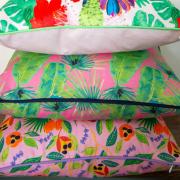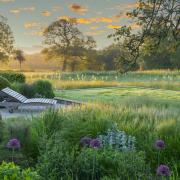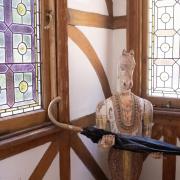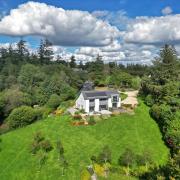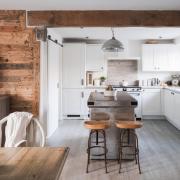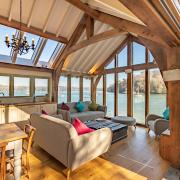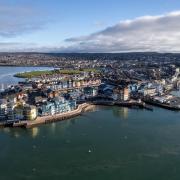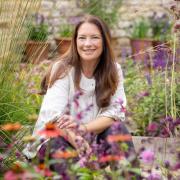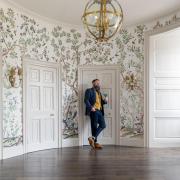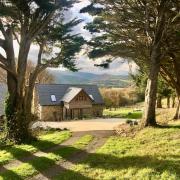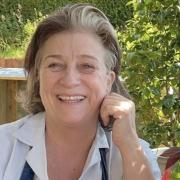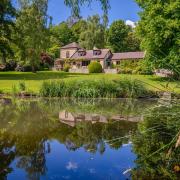Will Bees crafts beautiful fashion and interior items from his Salcombe workshop. A collaboration with former head of design at Liberty, Emma Mawston, has led to a stunning range of fabrics and the formation of a unique network of pollinator champions.
It seems appropriate that a series of unique heritage fabric designs which feature bees and flowers can trace its beginnings back to the world’s most famous flower show.
Bumblebee Garden was the first in a series of bee-centred fabric designs created for Will Bees Bespoke, which hand-makes interiors and fashion items from its waterside workshop in Salcombe.

It was the result of a meeting at the RHS Chelsea Flower Show between Will Bees, the founder and director of the brand, and Emma Mawston, the former head of design for Liberty Art Fabrics for 18 years.
Emma was at the show and came across Will Bees’s stall selling his handmade purses and backpacks using Liberty fabrics.
Will says: ‘Emma came to the stand and bought a product and then her husband came up and said, “She won’t tell you who she is, but I will!”
He revealed that Emma had hand drawn and designed the fabrics.

‘It was a joy bumping in to her,’ says Will. ‘We’d then meet at Chelsea and have a cup of tea and a chat. After three years or so we said, “Let’s do something together”.’
For a man named Will Bees to opt for a bee design on his fabrics seems obvious, and what’s more, he has a dog called Bumble, but choosing the bumble bee for their first collaboration was about much more than a play on words.
Emma, by then working freelance, had a lifelong love of drawing plants and flowers and had visited the South West on holiday since her twenties. So, Bumblebee Garden grew out of the flowers she painted on her visits to Devon and Cornwall, flowers which were loved by the buff-tailed bumblebee.

The flowers were sketched, then cut into a paper ‘cut garden’ before being traced onto hand-made paper and then hand-painted. The bees were painted separately and added into the flowers once the design had been scanned into the computer and the design, printed on heirloom velvet, was launched at Chelsea in 2021.
Bumblebee Garden marked the beginning of a much bigger and more involved collaboration involving not just Emma and Will but also a host of beekeepers, scientists and gardeners from across the country.
Emma, who describes herself as ‘a textile novelist’, has a natural inquisitiveness and desire to dig deep into the story behind her designs. While at Liberty she encouraged her team to work with collaborators, go on research trips and create visual and written write-ups. Designs were based on stories, ‘and every story was different,’ she says.

‘She’s a remarkable person to work with,’ says Will. ‘She puts so much research into everything and her attention to detail is off the scale.’
Donations from sales of Bumblebee Garden went to the Bumblebee Conservation Trust and it became involved in their second design collaboration
For Bee Story Emma and Will, along with Will’s colleague George Hoffman worked with the trust to find gardeners or ‘inspirational growers’ from 24 gardens across the country, all chosen to represent, celebrate and promote planting to help the survival of the 24 species of British bumblebee. Specific flowers were chosen by each grower including Devon organic farmer Emma Hydleman, Steve Gunn who has a Bumblebee Trust-inspired pollinator garden in North Devon and designer Linda Bassett who also keeps the bees happy in her garden in Bovey Tracey.
Will and George also chose flowers for the design. For George it was wisteria and for Will, the Japanese anemone, a plant loved by bumblebees but also one which ‘grows in the garden of a dear friend where many of the Will Bees photoshoots take place’.

The design took seven months to create and used over 50 flowers.
‘I felt like a textile gardener drawing and painting flowers, cutting them out and planting them on the paper where I thought they would grow best,’ says Emma. ‘The fact that it involved so many amazing passionate people made it very special for me.’
Meeting Jilly Halliday, who cares for native bees on Tresco on the Isles of Scilly, led to the next design Bee Tree and the formation of a Women and Bees Collective, a network which has now grown to 46 women who are all now involved in the Will Bees fabric designs including the upcoming Hexagon Hive, launched at this year’s Chelsea show and Meadow, to come later this year.
The women include Shelley Glasspool who work with native black bees at Widdicombe Apiaries; Donna Cox, co-founder of Moor Meadows; Clare Densely, a member of the bee team at Buckfast Abbey and Dr Grace Twiston-Davies, a researcher at Exeter University who co-owns the Wildflower Collective.

Emma talks about gardens, bees, the people who look after them and the need to raise awareness and protect their habitats with both excitement and passion. This work is clearly not just about creating designs for beautifully crafted accessories.
‘Finding out more about bees has been illuminating,’ says Will. ‘People need to know more about their importance, so a great way to do it is to tell a story through fabric, through something tactile.
‘The collective of women that Emma brought together are very passionate and we get into telling stories about what, why and how they are doing it. The public really engage with that.’
‘The synchronicity between the way both myself and Will Bees work is truly unique,’ says Emma. ‘Together we have formed a partnership based on craftsmanship, forming a collaboration between design, product and storytelling which is rare in the design world.’

The hobby that took off
Will Bees Bespoke is still in the building where Will first started his ‘hobby’, the former house husband had a passion for working with fabrics, and so filled in his time between school runs with ‘a sewing machine and some fabrics’.
In fairness he was actually both knowledgeable and skilled, having previously set up the clothing company Quba Sails.
‘I’d always been in the clothing industry, and we’d made bags, so it was always something I was fond of, that artistic creative side of things. I wanted to work with leather and use loads of different fabrics’

His workshop was in a old boatbuilding shed in Salcombe’s Island Street, and it proved the perfect, authentic setting for what was to launch in 2014 as Will Bees Bespoke and become a thriving full-time business.
From the beginning Will Bees had a free personalisation service for every item, something which at the time was a unique offering.
Will started off with 200 fabrics and quality of materials was a priority right from the beginning.
‘You can look at a number of fabrics or leathers, not knowing the price, and nine times out of ten I will pick the most expensive. I don’t know where it comes from... I think there’s a built in understanding of quality.’

The majority of items are all still made at the shop, (some larger items need certain machinery to be made, but are still made in England), so people can pop in and meet Will and seamstress Joss Hornby. Interacting with customers and telling them about the story of Will Bees is key, so much so that part of Joss’s time is allocated for chatting to people.
The cutting table, sewing machine and embossing machine are all on show, and walls are decorated with old tools. ‘I wanted it to have a vintage industrial look, with a bit of feminine chic, says Will. ‘It’s very rustic and honest’. And when the big back doors to the water are open in summer, it’s a pretty special place to both visit and work in.
‘We are lucky to get here, quite privileged,’ says Will.
willbeesbespoke.com

Honouring the lifesavers
A cushion made by Will Bees was used to carry an historic document to the altar during the RNLI’s 200th anniversary service of thanksgiving at Westminster Abbey.
A specially designed fabric was made for a new limited edition Will Bees collection to mark the anniversary year of the lifesaving charity.
Will Bees had been approached by the RNLI to create a design and so Emma became involved, and began her research.

She looked at archive images of the RNLI and listened to stories of its rescues as she worked on her drawings. She was inspired by the symbolism behind various RNLI badges and commemorative pieces produced over the years, including an old boat badge which she painted, ‘in a vintage way that wasn’t totally perfect, offering a weather-beaten image showing its many trips and life-saving voyages.’
There are anchors to symbolise crew members’ commitment and steadfastness, and rope, a symbol of unity, trust and faith and a metaphor for strength and stress.
She incorporated sealife images including coral, dolphins, puffins and whelks, and also more than 30 flowers and trees representing remembrance and the RNLI’s ethos of bravery, protection, gratitude and friendship. They include oak, for longevity and strength, and hawthorn which offers love and protection. Agapanthus, ‘the flower of love’ was used, as well as celandine representing the joy to come, passion flower for calm, strength and purity and sweet william for gallantry, protection and fighting for the cause.

Many of the chosen images were inspired by reading the ‘beautifully painted’ memorial books created to remember those who lost their lives during heroic rescues.
The design was painted on to wood, a link to the wooden boats which were used by the RNLI in its early days. ‘The wood grain was used to represent the sea, and waves were painted following the lines and swirls of the grain,’ says Emma.
The design was printed onto Will Bees’ velvet and hand cut by Will before being made into cushions and a range of bags, all available to buy on the RNLI’s website.
shop.rnli.org/collections/will-bees-collection




